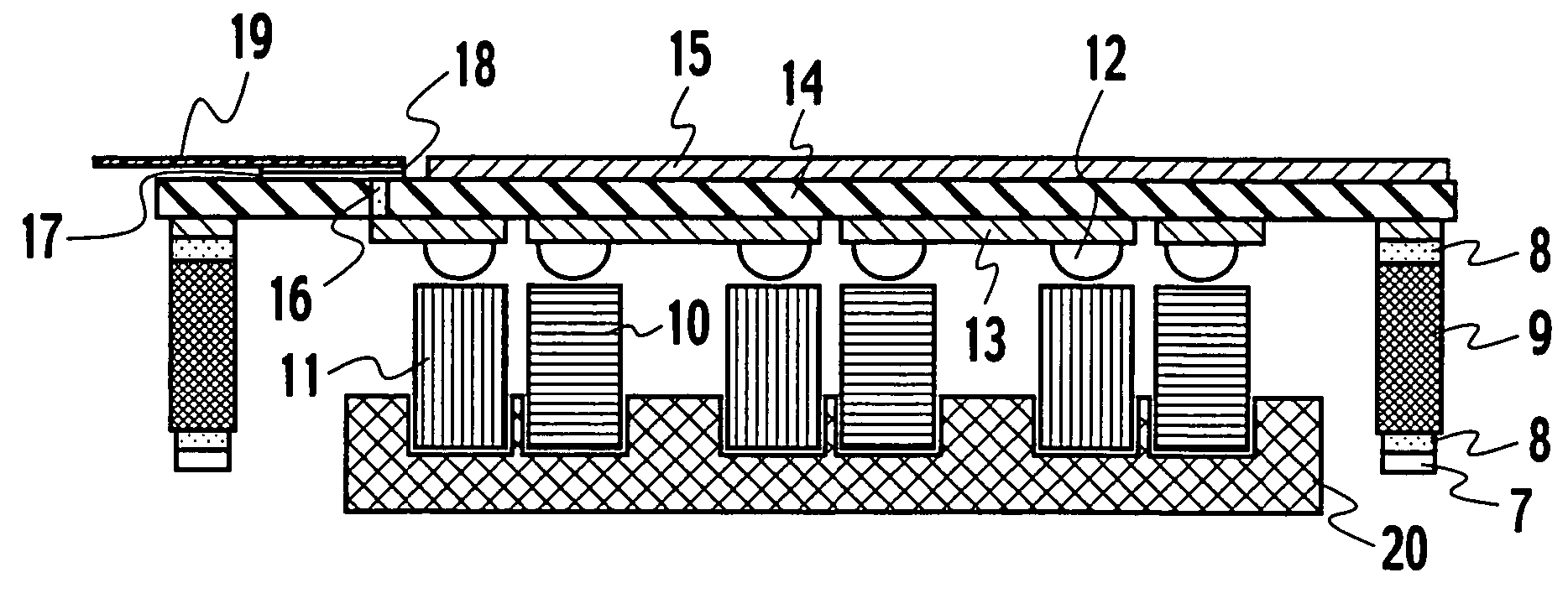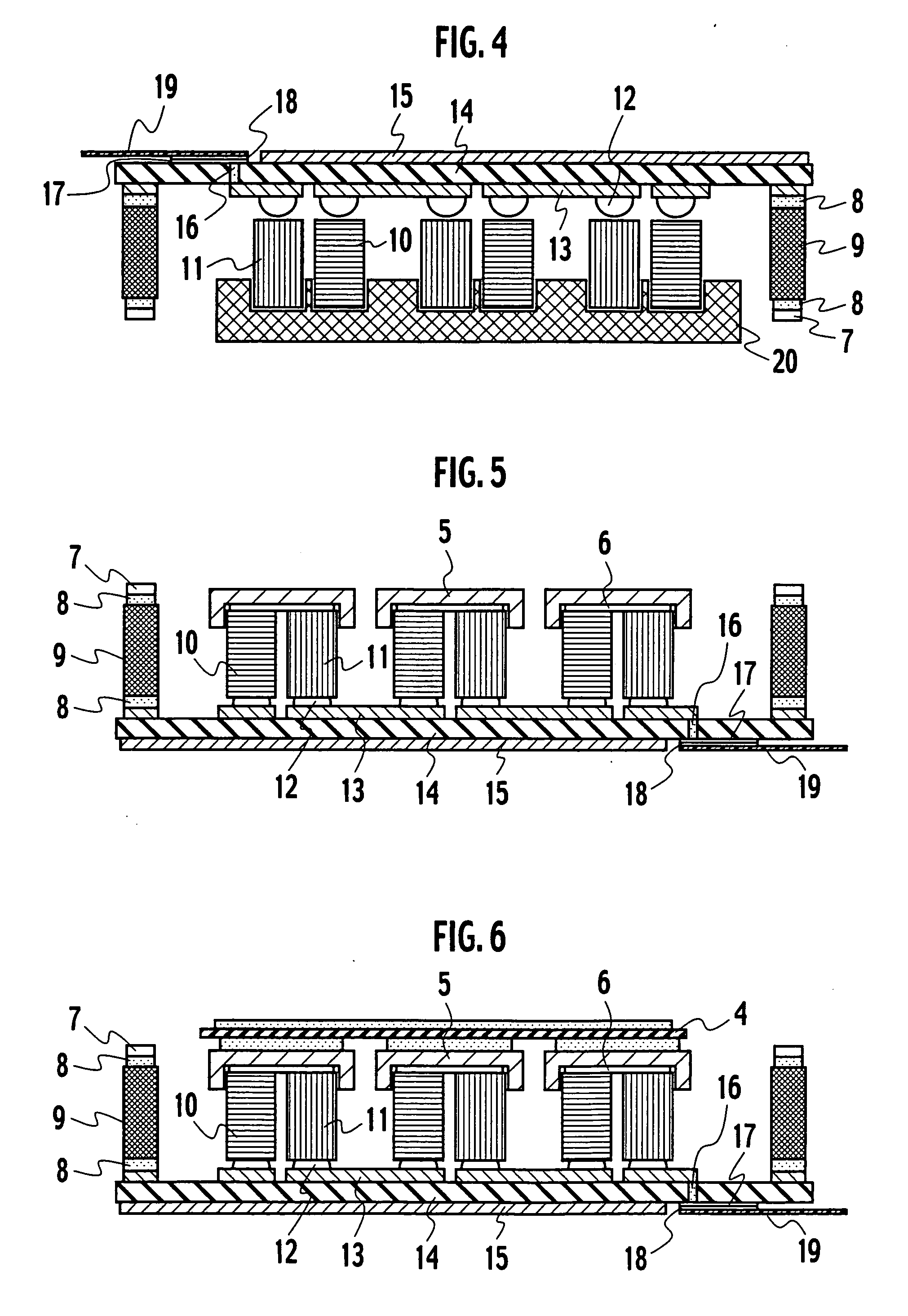Thermoelectric device
- Summary
- Abstract
- Description
- Claims
- Application Information
AI Technical Summary
Benefits of technology
Problems solved by technology
Method used
Image
Examples
first embodiment
[0032]FIG. 1 shows a cross-sectional structure of a thermoelectric device of a The thermoelectric device 1 includes a plurality of p-type thermoelectric elements 10 and n-type thermoelectric elements 11, one end surfaces of which are arranged on a heat-radiating-side board 14 serving as a wiring board. A plurality of heat-radiating-side electrodes 13, arrayed in accordance with positions where the respective thermoelectric elements 10 and 11 are to be arranged, are arrayed in an array fashion on a planer surface of the heat-radiating-side board 14. With regard to the p-type thermoelectric elements 10 and the n-type thermoelectric elements 11, the heat-radiating-side end surfaces of these thermoelectric elements and the heat-radiating-side electrodes 13 are joined to each other by solders 12.
[0033] On heat-absorbing-side end surfaces as the other end surfaces of the respective thermoelectric elements 10 and 11, a heat-absorbing-side insulating board 4, heat-absorbing-side electrodes...
second embodiment
[0049]FIG. 7 shows a cross-sectional structure of a thermoelectric device of a This thermoelectric device 21 is characterized in that the lid 2 and the heat-absorbing-side electrodes 5 are brought into direct contact with each other without separately preparing the insulating board.
[0050] It is necessary for the lid 2 to be joined to the frame 9 by welding in a similar way to the first embodiment, and accordingly, the lid 2 is made of metal. In this case, it is necessary that each of the heat-absorbing-side electrodes 5 be electrically independent of the others, and accordingly, it is necessary to electrically insulate the lid 2 and the heat-absorbing-side electrodes 5 from each other. In this connection, insulating films such as oxide films are formed on contact surfaces of the lid 2 with the heat-absorbing-side electrodes 5. Besides this, it is possible to constitute the thermoelectric device by depositing the insulating films on contact surfaces of the heat-absorbing-side electr...
third embodiment
[0052]FIG. 8 shows a cross-sectional structure of a thermoelectric device of a This thermoelectric device 22 is characterized in that a frame connecting a lid 71 and the heat-radiating-side board 14 to each other is composed of a frame 23 and a frame 24, which are obtained by dividing the frame into two in the height direction. The lid 71 and the heat-radiating-side board 14 are composed of ceramics such as Al2O3, and the frame 23 and the frame 24 are composed of, for example, Kovar in order to be welded.
[0053] The lid 71 having a metal portion 72 to which the frame 23 is brazed with silver brazing 8 interposed therebetween and the heat-radiating-side board 14 having a metal portion 73 to which the frame 24 is brazed with the silver brazing 8 interposed therebetween are fitted to each other on abutting surfaces of the frame 23 and the frame 24. Then, a portion where the frame 23 and the frame 24 overlap with each other is welded by laser. Furthermore, the sealing hole 3 is closed b...
PUM
| Property | Measurement | Unit |
|---|---|---|
| Pressure | aaaaa | aaaaa |
| Electrical conductor | aaaaa | aaaaa |
| Thermoelectricity | aaaaa | aaaaa |
Abstract
Description
Claims
Application Information
 Login to View More
Login to View More - R&D
- Intellectual Property
- Life Sciences
- Materials
- Tech Scout
- Unparalleled Data Quality
- Higher Quality Content
- 60% Fewer Hallucinations
Browse by: Latest US Patents, China's latest patents, Technical Efficacy Thesaurus, Application Domain, Technology Topic, Popular Technical Reports.
© 2025 PatSnap. All rights reserved.Legal|Privacy policy|Modern Slavery Act Transparency Statement|Sitemap|About US| Contact US: help@patsnap.com



